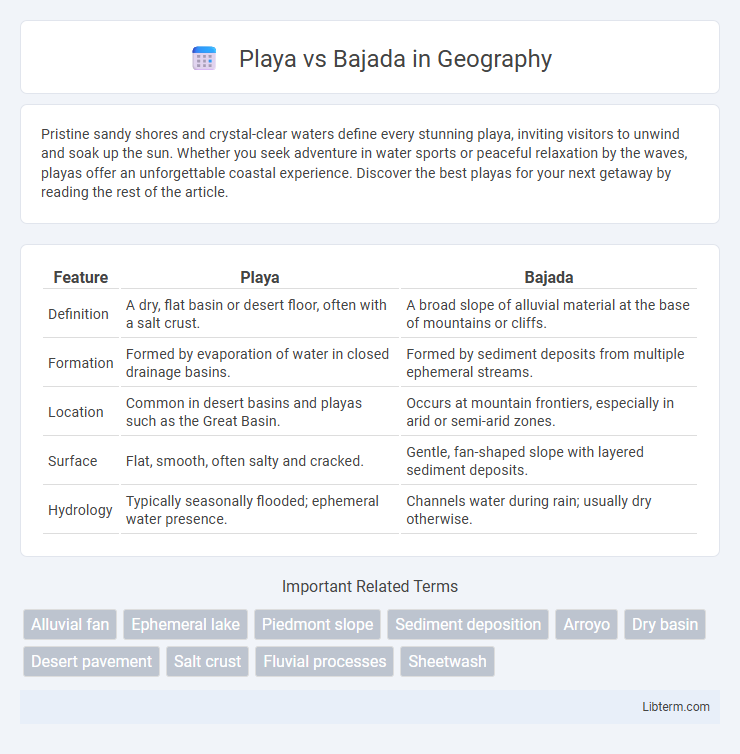Pristine sandy shores and crystal-clear waters define every stunning playa, inviting visitors to unwind and soak up the sun. Whether you seek adventure in water sports or peaceful relaxation by the waves, playas offer an unforgettable coastal experience. Discover the best playas for your next getaway by reading the rest of the article.
Table of Comparison
| Feature | Playa | Bajada |
|---|---|---|
| Definition | A dry, flat basin or desert floor, often with a salt crust. | A broad slope of alluvial material at the base of mountains or cliffs. |
| Formation | Formed by evaporation of water in closed drainage basins. | Formed by sediment deposits from multiple ephemeral streams. |
| Location | Common in desert basins and playas such as the Great Basin. | Occurs at mountain frontiers, especially in arid or semi-arid zones. |
| Surface | Flat, smooth, often salty and cracked. | Gentle, fan-shaped slope with layered sediment deposits. |
| Hydrology | Typically seasonally flooded; ephemeral water presence. | Channels water during rain; usually dry otherwise. |
Introduction to Playa vs Bajada
Playa and Bajada are two distinct geological formations found in arid and semi-arid environments. A playa is a dry lake bed that forms in basins, characterized by cracked clay surfaces and occasional ephemeral water presence. Bajada refers to a broad slope composed of coalescing alluvial fans, created by sediment deposits from adjacent mountains.
Defining Playa and Bajada: Key Differences
A playa is a dry lakebed or basin typically found in desert regions where water accumulates temporarily after rainfall, leading to a flat, often salty surface. A bajada, on the other hand, consists of a series of coalescing alluvial fans at the base of mountain ranges, formed by sediment deposits from intermittent stream flows. While playas represent closed drainage areas with fine sediments and ephemeral water, bajadas are inclined slopes composed of coarser debris spreading outward from highland runoff.
Formation Processes of Playa and Bajada
Playa forms through the evaporation of water in arid basins, leaving behind fine sediment and salts as the water body dries up. Bajada develops from the coalescence of multiple alluvial fans at the base of mountain fronts, where sediment transported by intermittent streams spreads out and deposits. Both landforms are shaped by sediment deposition but differ in hydrological and geomorphological processes driving their formation.
Geographical Locations of Playas and Bajadas
Playas are coastal landforms characterized by flat, sandy beaches adjacent to ocean shorelines, often found in arid or semi-arid regions. Bajadas consist of broad, gently sloping alluvial fans formed by the coalescence of multiple alluvial fans at the base of mountain ranges, primarily found in desert foothills. Both features play crucial roles in local geomorphology, with playas acting as dry lake beds and bajadas facilitating sediment deposition from upland erosion.
Physical Characteristics of Playa
Playa lakes are shallow, flat-bottomed basins that typically form in arid or semi-arid regions, characterized by fine-grained sediments such as clay, silt, and evaporites deposited during periodic flooding. They often lack persistent surface water and have smooth, gently sloping edges compared to the steeper, erosional slopes of bajadas, which are alluvial fans coalesced at the base of mountain fronts. Playa surfaces are usually saline due to high evaporation rates, distinguishing them from bajadas that consist primarily of coarse sediment layers like gravel and sand deposited by ephemeral streams.
Physical Characteristics of Bajada
Bajada is a broad slope formed by the coalescence of multiple alluvial fans, typically found at the base of mountain ranges in arid regions. Its physical characteristics include gently sloping, sediment-rich surfaces composed of sand, gravel, and rocks transported by intermittent streams during flash floods. Unlike a playa, which is a flat, dry lake bed often covered with salt deposits, a bajada represents a transitional zone where sediments accumulate, creating a distinctive geomorphological feature.
Environmental Significance of Playas and Bajadas
Playas are ephemeral lake beds that play a critical role in groundwater recharge and provide unique habitats for specialized flora and fauna in arid regions. Bajadas, formed by the coalescence of alluvial fans at the base of mountain fronts, serve as important sediment depositional zones that facilitate nutrient cycling and maintain soil stability in desert ecosystems. Both landforms contribute significantly to biodiversity conservation and water management in drylands, highlighting their environmental importance.
Ecological Roles in Desert Landscapes
Playa lakes, ephemeral and often saline, serve as critical habitats for migratory birds and specialized aquatic organisms in desert landscapes, supporting biodiversity and nutrient cycling. Bajadas, composed of coalescing alluvial fans, facilitate water infiltration and soil deposition, promoting vegetation growth and stabilizing slopes against erosion. Both landforms play complementary ecological roles by creating microhabitats that sustain desert flora and fauna amid arid conditions.
Economic and Human Uses
Playa lakes, primarily found in arid and semi-arid regions, serve as critical sources for groundwater recharge and support diverse agricultural activities by providing seasonal water availability. Bajadas, extensive alluvial fans composed of coalescing alluvial slopes at mountain bases, facilitate human settlement and infrastructure development due to their well-drained soils and relatively stable terrain. Both landforms are vital for regional economies, with playas contributing to livestock grazing and mineral extraction, while bajadas support urban expansion and transportation networks.
Comparative Summary: Playa vs Bajada
Playa and Bajada are distinct geomorphological features formed by sediment deposition in arid regions, with playas representing dry lake beds characterized by fine sediments and salt crusts, while bajadas consist of coalesced alluvial fans forming gentle slopes at the base of mountain fronts. Playas typically develop in basin bottoms where water accumulates and evaporates, leaving behind evaporite minerals, whereas bajadas result from the merging of multiple sediment-laden flows descending from highland areas. Understanding the differences in sediment composition, formation processes, and topographic settings aids in differentiating playa and bajada landscapes in desert environments.
Playa Infographic

 libterm.com
libterm.com